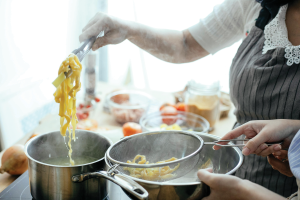It’s OK if you don’t like beets. There’s a dish for every taste on the Catholic table.
Jesus must have enjoyed eating. If his opponents called him “a glutton and a drunkard,” we can only guess that he loved a good dinner party. The scandal he caused, however, had less to do with what he ate than with whom: “tax collectors and sinners.”
The issue of who is welcome at the Christian table never really went away. The New Testament tells a story of a progressively larger table that came to include Roman soldiers, influential women, Gentiles rich and poor. But the question of who got a seat, based on both belief and behavior, was never without controversy.
Paul ruled out a long list in his Letter to the Romans. The North African theologian Tertullian and other ancient sources said no soldiers, and most early bishops had their lists of excommunicated heretics. In our own day political and moral questions create the boundaries, with authorities of varying degrees—from bishops to bloggers—holding forth.
Those with no recognized authority—most of the baptized—rarely get a sounding about what it takes to get a reservation, but we can thank Chicago priest and sociologist Andrew Greeley for one attempt, in his home archdiocese of Chicago. “What must one believe and do to be a good Catholic?” he asked this church in the heart of America. The answers, published in October, were a bit surprising.
Tied for first on the list of “very important” components of a Catholic identity came belief in Jesus’ resurrection and in the presence of God in the sacraments (81 percent of those interviewed), with faith in the presence of Jesus in the Eucharist, concern for the poor, and devotion to Mary tied for second (75 percent). Daily prayer, social justice, and angels and saints each cleared the 50-percent mark with 63, but weekly Mass attendance (46 percent), acceptance of papal infallibility (34 percent), regular confession (30 percent), and support for priestly celibacy (24 percent) sank to the bottom.
Catholics of left and right would find much to criticize in Greeley’s respondents when it comes to details. When asked what makes a “good Catholic,” 54 percent agreed that one should be married in the church, but less than 40 percent agreed that accepting the church’s teaching on abortion, divorce, gay marriage, and birth control were necessary. The church’s social doctrine fared no better: Less than 50 percent of respondents said church teaching on war and peace or the death penalty were mandatory. While 75 percent agreed that a “good Catholic” gives money to the poor, a mere 24 percent lined up with the church on immigration.
Even if they don’t buy everything their leaders preach, Chicago Catholics still hold them in high esteem. In the 2007 interviews Pope Benedict XVI garnered an 85 percent approval rating, Chicago’s Cardinal Francis George won 86 percent, and 9 out of 10 surveyed approved of their pastor.
What to make of these numbers? Greeley describes his fellow Chicagoans as “smorgasbord” (not “cafeteria”) Catholics, who find a “rich and diverse collection of ways to affirm their Catholicism.” Rather than lamenting the lack of comprehensive uniformity, he asks in all seriousness: “Who can fault an identity that includes the poor, the sacraments, the resurrection, the Eucharist, and Mary?” Indeed.
Catholics of all stripes may wish for greater agreement on the specifics of the faith, but Catholicism is simply too large a doctrinal, cultural, and sheer numerical reality to expect universal assent on all matters. That Chicago Catholics show as much agreement as they do is a miracle in itself.
Given the many bases to cover—whether moral issues or regular Mass attendance—isn’t it a good thing that Catholics have in effect divvied up the work? I for one am glad that there are Catholics out on the front lines battling abortion and homelessness and racism, while in my work as an editor I help tell their stories in ways that keep us all connected. And while the rosary may not suit my spiritual taste, I am delighted that many in the parish on my block take second and third helpings of devotion to the Blessed Mother.
I suppose some would prefer a prix fixe Catholic menu of carefully chosen appetizers and entrees instead of the smorgasbord Greeley’s research uncovered. But Catholicism has arguably always been more of a potluck than a carefully orchestrated dinner party. There are indeed main courses from which we all fill our plates, but with a table this large, we’re bound to favor some recipes over others.
This article appeared in the January 2011 issue of U.S. Catholic (Vol. 76, No. 1, page 8).











Add comment